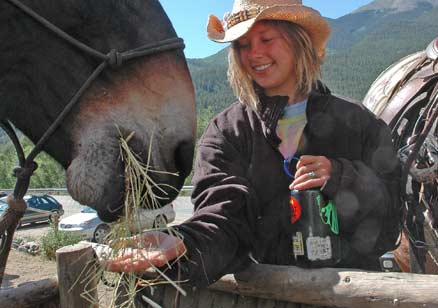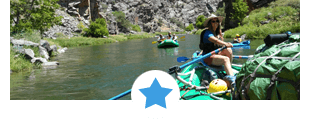Understanding Horse Behavior for Horseback Riding

Food offerings always makes horses happy
Horseback riding is one of the most popular outdoor activities to enjoy because it’s a great way to explore nature while bonding people and animals.
Before you head off to your next horseback riding trip, it’s important to understand how horses communicate and what their behavior is like.
When humans and animals understand each other, the bond and experience of horseback riding is even greater and more memorable.
Horse Culture
Horses are highly social herd animals that have a dominance hierarchy, or a pecking order. Usually, a herd of horses has one dominant mare that leads the herd and gets first dibs on resources and a lead stallion that stays on the outside of the herd in order to fight off predators or other males.
When not guarding, stallions drive up the rear when travelling to move stragglers forward. The pecking order helps all the horses to know how they relate to the others and they often travel in rank order.
They have a strong fight or flight instinct. When they are frightened, usually their first instinct is to escape and survive. If they can’t escape, then they resort to biting, kicking, rearing, or striking to protect themselves.
Horse Communication and Body Language
Before approaching a horse, it’s good to stand near and observe the way they communicate with each other. Animals are constantly showing how they are feeling through their body language. With horses, they have four common ways of communicating—vocalizing, touching, smelling, and body language. These are examples of what that looks like:
- Vocalize: nicker, squeal, whinny
- Touch: groom, nuzzle
- Smell
- Body Language: ear position, neck & head height, movement, foot stomping, tail swishing
With the pecking order, horses will discipline one another when they are out of line by first showing body language, then biting, kicking, or nudging the other horse.
A lot of a horse’s body language is similar to those of dogs and cats. The horse’s ears swivel towards what they are focusing their attention on, and can listen to sounds coming from in front and behind them at the same time. Keep an eye out for these indicators and what they mean:
- Whites of the eyes and ears flattened to back of head = fear or anger, pain
- Strong swishing tail and stamping hooves = fear anger
- Tail tucked in = cold or pain
- Raised tail = tension or excitement
- Flaring nostrils and snorting with intent eyes and ears = concern
- Bared teeth = anger about to bite
- Chewing motion with no food in mouth = self-soothing
- Extend upper lip when scratched = “Ohh, that’s a good spot”
Meeting the Horse
Keep in mind that as herd animals, horses view humans as predators. People tend to use operant conditioning to gain the trust of the horse and learn its body language. Remember that you are the horse’s leader, not a dictator. Keeping the horse’s feelings in mind will go a long way to building a strong bond between the two of you. If you are afraid of the horse, it will see this as human submission, which generally leads the horse into being more dominant and aggressive.
The approach to meeting a horse is similar to the appropriate manner to greet a dog and how dogs greet each other. Approach the horse on its left side in an arc instead of walking straight on. This tells the horse that you are not aggressive and would like to meet it in a friendly manner. Horses favor their left eye due to their rapid reaction eye and they prefer to keep people in their left line of vision.
It is very important to always approach the horse from the front and to the side and NOT from behind, where you put yourself at risk of startling the horse and getting kicked. Once you are next to the horse, off the back of your hand for her to smell and then pet her body.
Once you are ready to mount the horse, do so on the left side as well. Your horseback riding trail guide should’ve instructed you on how to sit on and communicate with the horse as well as how far to keep your horse from the other ones for healthy personal boundaries.
If you’d like to explore the woods on horseback, check out the horseback riding trips we have available.
At Wilderness Aware Rafting we love white water rafting and enjoying the great outdoors on horseback, mountain bikes, zip-lining, and camping. We have many exciting Salt River whitewater rafting or Colorado water rafting trips available. Want more adventure? We also have many other fun outdoor trips available.

